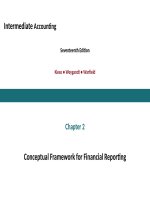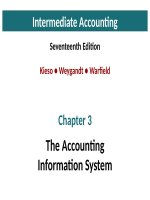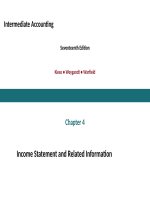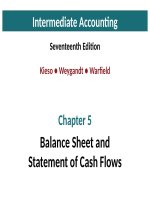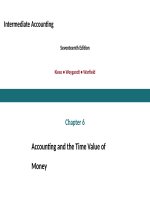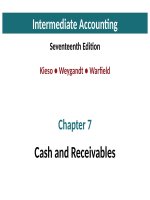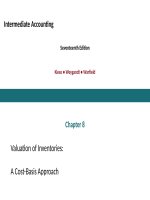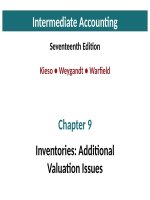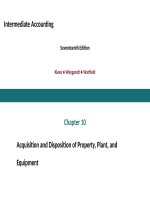Intermediate accounting 17e by kieso ch06
Bạn đang xem bản rút gọn của tài liệu. Xem và tải ngay bản đầy đủ của tài liệu tại đây (2.59 MB, 85 trang )
Intermediate Accounting
Seventeenth Edition
Kieso ● Weygandt ● Warfield
Chapter 6
Accounting and the Time Value of
Money
This slide deck contains animations. Please disable animations if they cause issues with your device.
Learning Objectives
After studying this chapter, you should be able to:
1.
Describe the fundamental concepts related to the time value of money.
2.
Solve future and present value of 1 problems.
3.
Solve future value of ordinary and annuity due problems.
4.
Solve present value of ordinary and annuity due problems.
5.
Solve present value problems related to deferred annuities, bonds, and expected cash flows.
Copyright ©2019 John Wiley & Sons, Inc.
2
Preview of Chapter 6
Accounting and the Time Value of Money
Basic Time Value Concepts
•
Applications
•
The nature of interest
•
Simple interest
•
Compound interest
•
Fundamental variables
Copyright ©2019 John Wiley & Sons, Inc.
3
Preview of Chapter 6
Single-Sum Problems
•
Future value of single sum
•
Present value of single sum
•
Solving for other unknowns
Annuities (Future Value)
•
Future value of ordinary annuity
•
Future value of annuity due
•
Examples of FV of annuity
Copyright ©2019 John Wiley & Sons, Inc.
4
Preview of Chapter 6
Annuities (Present Value)
•
Present value of ordinary annuity
•
Present value of annuity due
•
Examples of PV of annuity
Copyright ©2019 John Wiley & Sons, Inc.
5
Preview of Chapter 6
Other Time Value of Money Issues
•
Deferred annuities
•
Valuation of long-term bonds
•
Effective-interest method of bond discount/premium amortization
•
Present value measurement
Copyright ©2019 John Wiley & Sons, Inc.
6
Learning Objective 1
Describe the Fundamental Concepts Related to the Time Value of
Money
LO 1
Copyright ©2019 John Wiley & Sons, Inc.
7
Basic Time Value Concepts
Time Value of Money
•
A relationship between time and money.
•
A dollar received today is worth more than a dollar promised at some time in the future.
When deciding among investment or borrowing alternatives, it is essential to be able to compare
today’s dollar and tomorrow’s dollar on the same footing—to “compare apples to apples.”
LO 1
Copyright ©2019 John Wiley & Sons, Inc.
8
Applications of Time Value Concepts
Present Value-Based Accounting Measurements
1.
2.
3.
4.
LO 1
5.
Notes
Leases
Benefits
6.
7.
Long-Term Assets
8.
Pensions and Other Postretirement
Copyright ©2019 John Wiley & Sons, Inc.
Shared-Based Compensation
Business Combinations
Disclosures
Environmental Liabilities
9
The Nature of Interest
•
Payment for the use of money
•
Excess cash received or repaid over the amount lent or borrowed (principal)
Variables in Interest Computation
1.
Principal. The amount borrowed or invested.
2.
Interest Rate. A percentage of the outstanding principal.
3.
Time. The number of years or fractional portion of a year that the principal is outstanding.
LO 1
Copyright ©2019 John Wiley & Sons, Inc.
10
Simple Interest (1 year)
Interest computed on the principal only.
Illustration: Barstow Electric Inc. borrows $10,000 for 3 years at a simple interest rate of 8% per year.
Compute the total interest to be paid for the 1 year.
Annual Interest
Interest = p x i x n
= $10,000 x .08 x 1
= $800
LO 1
Copyright ©2019 John Wiley & Sons, Inc.
11
Simple Interest (3 year)
Interest computed on the principal only.
Illustration: Barstow Electric Inc. borrows $10,000 for 3 years at a simple interest rate of 8% per year.
Compute the total interest to be paid for the 3 years.
Total
Interest = p x i x n
Interest
= $10,000 x .08 x 3
= $2,400
LO 1
Copyright ©2019 John Wiley & Sons, Inc.
12
Simple Interest (3 months)
Interest computed on the principal only.
Illustration: Barstow Electric Inc. borrows $10,000 for 3 months at a simple interest rate of 8% per
year, the interest is computed as follows.
Partial Year
Interest = p x i x n
Interest
= $10,000 x .08 x 3/12
= $200
LO 1
Copyright ©2019 John Wiley & Sons, Inc.
13
Compound Interest
•
•
LO 1
Computes interest on
principal and
interest earned that has not been paid or withdrawn
Typical interest computation applied in business situations
Copyright ©2019 John Wiley & Sons, Inc.
14
Compound Interest
Simple vs. Compound Interest
Illustration: Tomalczyk Company deposits $10,000 in the Last National Bank, where it will earn simple interest of 9% per year. It
deposits another $10,000 in the First State Bank, where it will earn compound interest of 9% per year compounded annually. In both
cases, Tomalczyk will not withdraw any interest until 3 years from the date of deposit.
LO 1
Year 1 $10,000.00 x 9%
$ 900.00
$ 10,900.00
Year 2 $10,900.00 x 9%
$ 981.00
$ 11,881.00
Year 3 $11,881.00 x 9%
$1,069.29
$ 12,950.29
Copyright ©2019 John Wiley & Sons, Inc.
15
Compound Interest Tables
Table 6.1 - Future Value of 1
Table 6.2 - Present Value of 1
Table 6.3 - Future Value of an Ordinary Annuity of 1
Table 6.4 - Present Value of an Ordinary Annuity of 1
Table 6.5 - Present Value of an Annuity Due of 1
Number of Periods = number of years × the number of compounding periods per year.
Compounding Period Interest Rate = annual rate divided by the number of compounding periods per year.
LO 1
Copyright ©2019 John Wiley & Sons, Inc.
16
Compound Interest Tables
(Excerpt from Table 6.1)
Future Value of 1 at Compound Interest
Period
4%
5%
6%
1
1.04000
1.05000
1.06000
2
1.08160
1.10250
1.12360
3
1.12486
1.15763
1.19102
4
1.16986
1.21551
1.26248
5
1.21665
1.27628
1.33823
How much principal plus interest a dollar accumulates to at the end of each of five periods, at three different rates of
compound interest.
LO 1
Copyright ©2019 John Wiley & Sons, Inc.
17
Compound Interest Tables
Formula for future value factor (FVF) for 1
FVFn ,i = ( 1 + i )
n
Where:
FVFn,i = future value factor for n periods at i interest
n = number of periods
i = rate of interest for a single period
LO 1
Copyright ©2019 John Wiley & Sons, Inc.
18
Compound Interest Tables
Frequency of Compounding
Determine number of periods by multiplying number of years involved by number of compounding periods
per year.
12% Annual Interest Rate over 5 Years
Interest Rate per Compounding Period
Number of Compounding Periods
Compounded
Annually (1)
.12 ÷ 1 = .12
Semiannually (2)
.12 ÷ 2 = .06
Quarterly (4)
.12 ÷ 4 = .03
Monthly (12)
.12 ÷ 12 = .01
LO 1
Copyright ©2019 John Wiley & Sons, Inc.
5 years × 1 compounding per year = 5 periods
5 years × 2 compoundings per year = 10 periods
5 years × 4 compoundings per year = 20 periods
5 years × 12 compoundings per year = 60 periods
19
Compound Interest Tables
Comparison of Different Compounding Periods
A 9% annual interest compounded daily provides a 9.42% yield.
Effective Yield for a $10,000 investment.
LO 1
Copyright ©2019 John Wiley & Sons, Inc.
20
Fundamental Variables
LO 1
•
Rate of Interest
•
Number of Time Periods
•
Future Value
•
Present Value
Copyright ©2019 John Wiley & Sons, Inc.
21
Learning Objective 2
Solve Future and Present Value of 1 Problems
LO 2
Copyright ©2019 John Wiley & Sons, Inc.
22
Single-Sum Problems
Two Categories
Unknown Present Value
LO 2
Unknown Future Value
Copyright ©2019 John Wiley & Sons, Inc.
23
Future Value of a Single Sum
Value at a future date of a given amount invested, assuming compound interest.
(
FV = PV FVFn ,i
)
Where:
FV = future value
PV = present value (principal or single sum)
FVFn, i = future value factor for n periods at i interest
LO 2
Copyright ©2019 John Wiley & Sons, Inc.
24
Future Value of a Single Sum
Illustration
Bruegger Co. wants to determine the future value of $50,000 invested for 5 years compounded annually at
an interest rate of 6%.
Future value = PV( FVFn,i )
= $50, 000(FVF5,6% )
= $50, 000(1+ .06)5
= $50, 000(1.33823)
= $66, 912
LO 2
Copyright ©2019 John Wiley & Sons, Inc.
25
